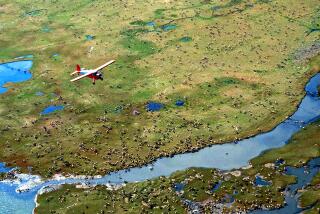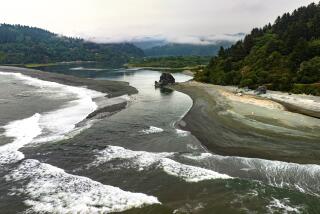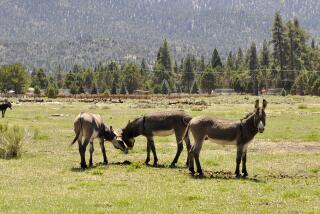Lifestyle in Hunters’ Cross Hairs
- Share via
KOYUKUK, Alaska — In this settlement of makeshift log cabins and rutted roads deep in the Yukon wilderness, a place where the dim midwinter sun slinks above the horizon an hour and a half a day, there is no winter without a moose in the freezer. There is no summer without chinook salmon drawn out of the river, no fall without field cranberries.
Moose season closed last month and Percy Lolnitz came back without one. Not for lack of looking: Lolnitz, his pregnant wife and his two boys piled into a small aluminum boat and motored 200 miles of the Koyukuk River. Lolnitz shouldered his rifle and walked deep into the spruce forests that line the river. He scanned the secret meadows only he and his fellow Athabaskan Indian villagers know about.
But mostly what he saw was other hunters. The upper Koyukuk saw a record 626 hunters last year, most of them from places like Anchorage and New York. He saw urban hunters in camouflage jackets loading moose meat onto boats, hunters handing cameras to their buddies to get their pictures taken next to big bull moose heads. He saw what some of them left behind: hunks of rotting moose meat, with only the prized antlers hauled away.
“I don’t know what we’re going to do,” Laurie Lolnitz, his wife, said. “Mom has some moose meat, but it’s not going to be enough.”
With an ever greater number of urban hunters trekking into the bush and a booming commercial fishing industry now approaching $1 billion a year, the issue of subsistence hunting and fishing has evolved into one of the biggest political conflicts Alaska has faced since statehood in 1959.
Rural Alaska remains the only place in America where whole communities still survive off the land and water around them. Last year, Alaska’s 100,000 natives harvested 43 million pounds of wild foods. Otherwise, they are at the mercy of expensive food deliveries by bush plane and tiny village groceries whose fresh produce usually consists of a wilted head of lettuce and a few apples stuck forlornly in the back of a refrigerator case.
For decades, the state granted native Alaskans hunting and fishing preferences--such as an early start on a hunting season. But the Alaska Supreme Court declared the preferences unconstitutional in 1989.
The U.S. Interior Department said in 1990 that it would enforce hunting preferences for natives on federal land, but only infrequently has it had to exercise that authority. Last week, when the state Legislature failed to put on the ballot a constitutional amendment guaranteeing a statewide preference for rural hunters and fishermen, Interior Secretary Bruce Babbitt announced a federal takeover of subsistence fishing regulations along federal waterways as well.
Legislators Resist Federal Demands
The move was welcomed among Alaska’s 220 native communities, but for many urban legislators, the takeover amounts to a declaration of war.
“The fact that the federal government is telling the state of Alaska to amend our constitution basically makes us a second-class state,” said Republican state Rep. Scott Ogan, a leader in the fight to resist federal demands for a rural preference.
“People all over the West should be looking at this, because if the federal government is allowed to tell the people of Alaska who can hunt here and who can fish here, then they’re equally entitled to tell the people of California who can pick berries on federal lands,” said Ralph Seekins, head of the Alaska Wildlife Conservation Assn., an organization of mainly urban sportsmen.
The Alaska Federation of Natives was deeply critical of the Legislature’s failure to seek a statewide vote granting a rural preference on hunting and fishing all over Alaska. Such a preference would have helped rural residents in places like Koyukuk, where most of the available hunting is on state-controlled lands.
“We believe that, as the last native people living on their own land, that have not been herded off onto reservations, you have something unique going on,” said federation president Julie Kitka. “The bottom line is, everybody depends on subsistence. That disappears, and you have totally wiped out a way of life.”
Several villages already have closed off access to outside hunters and fishermen; while they have not been challenged, their authority to do so is, in some cases, questionable. Some villages have launched tribal patrols to monitor nonresident hunters.
The subtext of the subsistence debate is that there are two Alaskas: There is the Alaska of Anchorage, Juneau and Fairbanks, which tends to see the bush as a weekend playground and a lucrative source of fishing and tourism revenue. And there is the Alaska of Koyukuk, whose 85 residents depend for their very survival on the salmon in the river and the fabled big bull moose of the upper Koyukuk that have become an autumn lure for hunters.
Some pay professional guides upward of $6,000 to help them hunt a single moose. And after two years of record numbers of hunters, the moose populations are dropping to worrisome levels in the region of the river. Many of the moose, game managers say, have apparently been driven into the inaccessible back country by traffic along the river.
“We can’t keep going like this,” Ethel Esmailka, 60, who has spent her life on the Koyukuk River, said one recent afternoon, standing over a cutting table stacked with moose meat. “The villages are getting tough now. They’re putting their foot down. I’m not talking nothing about whites, but it’s getting mean. My grandchildren gotta eat.”
Fishing, without any federal subsistence protections until now, has been even more problematic in many rural communities. Alaskan communities last year sought $50 million in federal disaster assistance to offset the effects of collapsed salmon runs, and communities along the Yukon and Koyukuk rivers were among the hardest hit by record-low numbers of chum salmon.
A federal takeover, native leaders believe, guarantees rural communities first crack at dwindling fish runs, before the resources are set upon by a commercial fishing industry that harvests 98% of all the fish caught in Alaska.
Although native Americans throughout the U.S. have had their treaty rights to traditional hunting and fishing upheld by the courts, Alaska remains the only place where hundreds of entire communities eke the bulk of their living out of the forests and rivers around them.
Their total take is small: less than 2% of all the fish and wildlife harvested in Alaska. Yet native groups say the very survival of the Athabaskan, Inupiat, Aleut, Tlingit, Alutiiq and Yup’ik cultures is at stake. At a forum on subsistence issues in Washington, D.C., earlier this month, lawmakers like longtime civil rights leader Rep. John Lewis (D-Ga.), called the subsistence debate a national civil rights issue.
“The right of the Eskimo, the Aleut and the Indian people of Alaska to get food to feed their children is not a special right, it is a basic human right,” Lewis said. “For us to stand by and allow the native people of Alaska to be denied their rights, that would diminish us all.”
Village Elder Sees Stocks Decline
Koyukuk’s only connections to nearby Yukon villages are bush planes and the small aluminum boats that regularly ply the wide river.
Eliza Jones, a village elder, recounted how she used to load her family into a small aluminum boat every summer. They would motor 420 miles down the river from Fairbanks, where her husband had a job as a heavy equipment operator, and put up fish for the winter, smoke it and can it. Every fall, the family would go out for a moose.
“Thirty years ago, we’d go out for one day, we’d go out a few miles and get our moose and come back,” she said. “These days, you go out 130 miles and stay up there for a week.”
“I know that river, and I know . . . it’s declining, and it scares the heck out of me. Because those moose are the main diet for us,” Lolnitz said. “There’s hundreds and hundreds of [outside] hunters up there right now. We feel like we’re losing, and we are.”
In some ways, the annual moose hunt is much more than a search for winter meat. If their sons don’t know how to follow moose tracks in the woods, how to fire a rifle and hit a moose before it slips into the brush, if their daughters don’t know how to hang moose meat strips in the smoke house, what will hold them to places like Koyukuk?
Lolnitz’s 9-year-old niece, when she isn’t in school, spends hours playing Nintendo. Her 11-year-old son stands outside with a portable stereo, a blue bandanna tied around his head, swaying and thrusting to hip hop tunes.
“In the mid-70s, when non-natives first started heading up the river, there used to be shootings at boats and planes, things like that. They said it was the village boys from Koyukuk,” Lolnitz said. “They were sinking boats, shooting at air taxis. Then they brought in the game warden plane, and they started trying to monitor the local natives, I guess. They weren’t monitoring the moose, that’s for sure.”
Percy Lolnitz has joined a native team that patrols up the Koyukuk River. Last month, he found the meat of an entire moose left to rot on the river bank by a trophy hunter who had illegally failed to salvage the meat, keeping only the antlers and the skin. A few miles away, he found the carcass of a black bear, its head, paws and skin removed. He snapped photos on a Polaroid to show the state game warden. When a hunter from upper New York state proudly showed him his huge moose head, the meat cast aside for whoever might want it, Lolnitz snapped a photo of that, too. The hunter thought it was because Lolnitz admired the size of his moose head.
Sportsman Indignant at Idea of Preference
At the big Ford dealer on Fairbanks’ main expressway, owner Ralph Seekins, of the sportsmen’s conservation group, has a decorated moose rack in his office and has just returned from his annual hunt. Seekins says he has no objection to providing subsistence rights for those who need them, but that a blanket rural preference isn’t fair.
What about the native people in Anchorage and Fairbanks who may need the meat but who don’t qualify as rural? “The federal government wants to set up an apartheid system based on ZIP code, nothing else,” Seekins declared. “What’s wrong with equality?”
The federal fishing takeover last week has commercial fisherman worried. With recent disastrous salmon runs on interior rivers, federal officials have talked of the possibility of restricting large harvests to leave more fish available to subsistence communities.
“If somebody’s not catching enough fish in Tanana, they could file a complaint and say we need to restrict commercial fishing off in the ocean,” said Tom Gemmell, administrator of the United Fishermen of Alaska. “The thing we prefer is to have this issue worked out here in the state, and not by some bureaucracy in Washington.”
Polls show that a large number of Alaskans, rural and urban, are happy to give rural residents who need it a priority on fishing and hunting, but in the end, Seekins said, rural residents have the choice of leaving if they can’t make a living in their villages. “My mom wanted me to stay in the little village where I grew up, and I moved away because there wasn’t going to be a job for me there,” he said. “Where does it say we have to freeze a culture at a certain point in history? Are we going to trap these people out there in the villages and say you can’t come out of there? Is that a form of a human zoo if we do that?”
Byron Mallott, a Tlingit clan leader who was co-chairman of a study this year on rural governance, said he is tired of urban Alaskans telling villagers where and how they ought to live.
“Public policy in Alaska is led mostly by those who would have us disappear,” he said. “All of Alaska’s native people have worked so hard to accommodate the interests of other Alaskans. We have moved aside, we have changed, we have done everything that has been mandated of us to be good Alaskans. It is time for Alaskans to reciprocate.”
More to Read
Sign up for Essential California
The most important California stories and recommendations in your inbox every morning.
You may occasionally receive promotional content from the Los Angeles Times.










